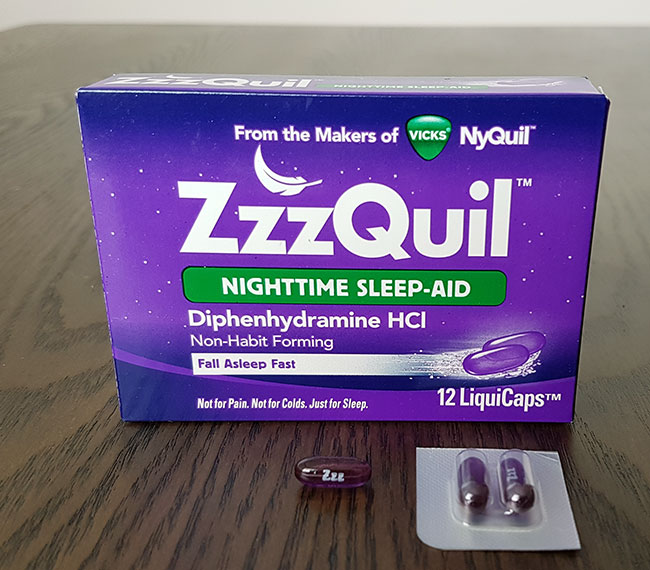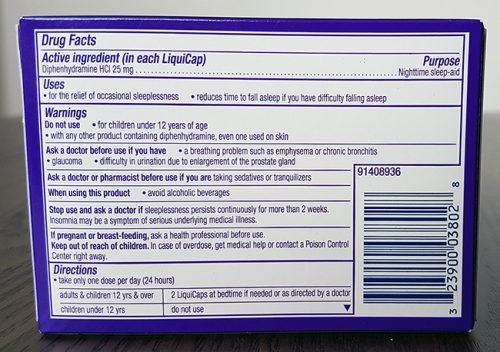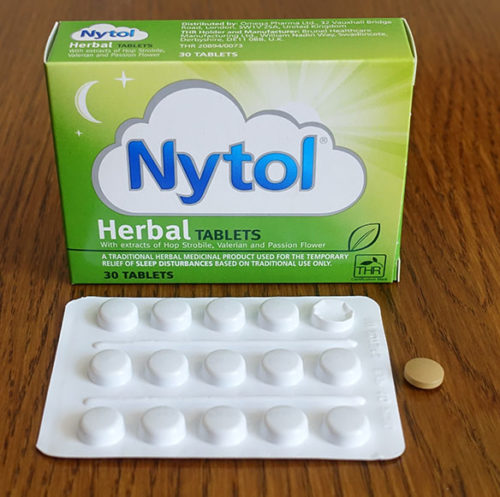
I recently tested the non-prescription sleep aid ZzzQuil for several nights to see if it would help me sleep better. It’s made by Vicks, who also make Benadryl, a popular product for allergies.
The main ingredient of ZzzQuil is the antihistamine diphenhydramine, which is also used in other sleep aids I’ve tried, such as Nytol One-A-Night. Interestingly, it’s also the main ingredient of Benadryl in the United States and Canada, though not in the UK.
Note that ZzzQuil Nighttime Sleep Aid is not the same as ZzzQuil Pure Zzzs. The version I’m talking about in this article contains diphenhydramine, whereas ZzzQuil Pure Zzzs contains melatonin and herbal ingredients instead.
My experience

I took just one ZzzQuil liquicap to test it on the first night, rather than the recommended dosage of two caps. I noticed that the liquicap is smaller and smoother than the standard white pills that many brands use, so it’s a bit easier to swallow.
I’d actually tried to go to sleep naturally at first, but was struggling to sleep because of the heat. So I got up around midnight, took the ZzzQuil, and tried to fall asleep again. Interestingly, my sleep tracker data for that night showed that I was in and out of light sleep until around 30 minutes after taking it.
After that, I slept straight through the night without any wakings that I could remember. I apparently got 7 hours 20 minutes of sleep, which was the first time I’d managed over 7 hours in a while.
Fuzzy head in the morning
When I woke up, I had a slightly fuzzy head. It wasn’t too bad though, and I felt back to normal around an hour later. This isn’t unusual with antihistamine sleep aids in my experience, and it was tolerable.
Night 2
I decided to take the full dose of two liquicaps this time and then lay in bed reading to see if I noticed a sedative effect.
I didn’t feel super drowsy while reading, but I perhaps felt a little sleepy after around 40 minutes, so turned the light off to go to sleep. I had a couple of wakings in the night, but they were only a few minutes long. So again, it was a relatively good night’s sleep.
My sleep tracker also recorded that I got more REM and deep sleep than normal. Although I always take a sleep tracker’s sleep stages data with a pinch of salt, it’s still interesting that it showed more time spent in those restorative stages of sleep.
The hangover effect
Compared to the mild cloudy head of the previous morning, there was a much more noticeable hangover effect on the morning after the second night of trying ZzzQuil . Whether it was because I took the full dose this time, two nights in a row taking it, or something unrelated, I’ll never know.
But I woke with a headache, a heavy feeling in my eyes, and a cloudiness to my thinking that took a couple of hours to completely disappear.
Night 3
I took the full dose again and had a very similar experience as the second night. I woke up several times randomly in the night, but never for more than five minutes.
The fuzzy head effect was waiting for me in the morning again, which took a couple of hours to disappear completely.
Night 4
I decided to try just the single dose again on the final night. I didn’t sleep as well as the previous nights, taking a little longer to go to sleep, and waking up for longer periods in the night. I had a slightly foggy head, but not nearly as much as on nights two and three.
Conclusion
Both my manual sleep diary and sleep tracker suggest that the ZzzQuil increased my total sleep time – especially with the full dose. There also appeared to be an improvement in the number of wakings in the night compared to the week before, and in how long it took me to fall asleep after waking.
Comparatively, taking two liquicaps may have led to shorter wakings than just one liquicap. However, there was also a big difference in the hangover effect according to the dosage. I think if I were to take ZzzQuil again, I’d stick with 25 mg. Even if the full 50 mg keeps me asleep for longer, the grogginess I felt in the morning tips the balance in favor of a lower dose.
Further information
ZzzQuil Ingredients

Active ingredient
There was one active ingredient listed on the pack I bought – 25 mg diphenhydramine HCL (hydrochloride)
Inactive ingredients
- FD&C Blue No. 1
- FD&C Red No. 40
- Gelatin
- Glycerin
- Pharmaceutical ink
- Polyethylene glycol
- Purified water
- Sorbitol sorbitan solution
Dosage
The instructions on my box recommended taking two liquicaps at bedtime if you’re an adult or child 12 years and over. That means a dosage of 50 mg. Like me, you might prefer to take just one to have a milder effect.
Warnings / who shouldn’t use it
ZzzQuil doesn’t come with an extensive patient leaflet, but there are some important warnings on the back of the box:
Do not use
- Children under 12.
- With any other product that contains diphenhydramine (even for the skin).
Ask a doctor before use if you have
- A breathing problem, e.g. emphysema or bronchitis.
- Glaucoma.
- Difficulty urinating because of enlargement of the prostate gland.
Ask a doctor or pharmacist
- If you’re taking any other sedatives or tranquilizers.
When using Zzzquil
- Avoid alcoholic beverages.
If pregnant or breastfeeding
- Ask a health professional before use.
Warnings for older adults
The current guidelines in the United States is that older adults should avoid sleep aids containing first generation antihistamines like diphenhydramine. Older adults are thought to be at higher risk of some of the side effects, such as confusion and anticholinergic effects.
I recommend consulting your doctor before taking any sleep aid containing these ingredients, and not to try them until you get professional medical advice.
If you’d like to do some of your own background reading on this issue, here are some sources to start with:
Pharmacytoday.com – they list the different medicines that are not recommended for older adults according to the Beers criteria, which is used to guide healthcare practitioners in the US.
Research study in 2017 – researchers at the University of Pittsburgh published a study about this issue, and discuss it at length. One of their conclusions makes it clear:
A majority of older adults in a limited sample from the United States taking an over-the-counter medication to improve sleep are taking a product containing diphenhydramine or doxylamine, both of which are classified as potentially inappropriate for older adults.
Side effects
The box didn’t come with any information about possible side effects. And with no accompanying patient leaflet, I was left to investigate this myself. Fortunately, there’s plenty of information about the possible side effects of diphenhydramine available online. You could also ask your primary care doctor or pharmacist what side effects to look out for if you take it.
The website Drugs.com has an extensive list of side effects on its diphenhydramine page.
The main ones they highlight for consumers are:
- Sedation/sleepiness (the aim of using it as a sleep aid!)
- Dizziness
- Disturbed coordination
- Epigastric distress (pain or discomfort in the abdomen)
- Thickening of bronchial secretions
- Headache
- Dry mouth
There are several other side effects that are reported as rare on drugs.com, which you might like to look through before taking ZzzQuil.
Interactions
Drugs.com is also a good source of information about interactions with other medications, of which there are 405 listed at the time of writing. If you’re taking any other drugs, you can search for that specific interaction on their website.
It’s also a good idea to talk to your personal doctor if you’re using any other medication to be sure it’s safe for you.
What others say
I didn’t find any serious articles online from other bloggers or medical writers. However, there are many customer reviews on sites that sell it. At the time of writing, some examples include:
- Target: 4.2 out of 5 stars (16693 customers)
- Amazon: 4.6 (4549 customers)
- Walmart: 4.1 (66732 customers)
I read several hundred of the longer comments and found they follow a similar pattern to many other over the counter sleep aids. Some people say they work wonders, while others report that they did nothing for them.
And there are many people who say ZzzQuil worked, but they had a similar hangover effect as I did in the morning.
Your experience of ZzzQuil
Have you tried it? Did it work for you, or give you any side effects? Please share your experience in the comments below.





Just trying to fine out if there’s a gallon jug refillable for better cost. When you have more then one person in the house they go fast. Thanks
Hi Jack
I don’t think they exist in that size. Have a look around online though, as sometimes you can get deals for multi-packs of these kind of sleep aids.
Regards
Ethan
I took a dose of nyquil zzz and woke up and had blurred and double vision all day…will this go away on its own?
Hopefully it has gone away by now John. If not, I’d definitely speak to your doctor, and needless to say not take any more.
Regards
Ethan
Didn’t like the way it made me feel the next day .
Like I never sleep all night, got up at 6 and it’s 10 this morning, and l feel like l drank all night. hate the feeling.
Hi there
Sounds like this definitely isn’t a good one for you then.
Thanks for sharing.
Ethan
I have been taking this stuff for a few months now. I also have lost weight in the last couple of months. I have noticed headaches when waking, sweating, dry mouth, and extreme grogginess during the day. I was ok before the weight loss but after the weight loss as my body got smaller the side effects became apparent. I thought I was suffering from some illness but low and behold the symptoms match the side effects of the medicine. I knew I wasn’t crazy after all.
Hi Chrissy
Thanks for sharing your experience. It must be a relief to have worked out what was really going on. Did you feel better after stopping taking them, assuming you have done now?
Regards
Ethan
I took two capsules it did not work
Hi Jasmine
Thanks for sharing your experience.
Regards
Ethan
I easily get off to sleep but my problem is staying asleep. I tend to wake several times throughout the night which makes for a very broken sleep and almost a dread of going to bed. I do find that even one glass of wine affects my sleep negatively so I decided to stop drinking completely for two months and during that time I took zzzquil almost every night. I take the liquid and probably took about a third of a dose each night. I slept so so well during that period. I looked and felt much better than I had in some time. Now is that a result of not drinking ( I am not a heavy drinker at all) or sleeping better or a combination of both? I tend to think it’s a combination of both. To that point, I have decided that my sleep is more important than a glass of wine so I have decided to give up alcohol again and take zzzquil in the hope of sleeping better. The side effects mentioned in other reviews, I do not experience but then again, I only take a very small amount.
Hi there
Thanks for sharing your experience. To be honest, I have the same question sometimes! I also know that even a small ammount of wine can affect my sleep. Frustratingly though, it’s not always the same effect – sometimes I will sleep fine (if I’m exhausted), so I think it’s more a case of if I’m not too tired and then have a couple of glasses in the evening, it can disrupt my sleep. I also know that when I go teetotal for a few weeks, my sleep generally improves though, so I do think alcohol has a key role to play.
At the end of the day, if you can control your sleep naturally, that can only be the best outcome. So if you can forgo the alcohol without missing it or feeling like you miss out on social activities, and also not take sleep aids, and sleep well – that would be a win!
Regards
Ethan